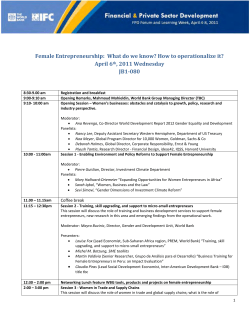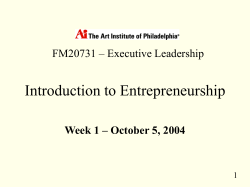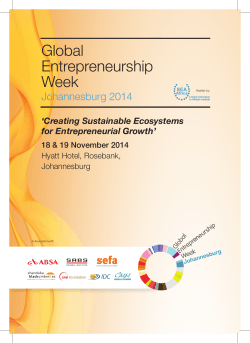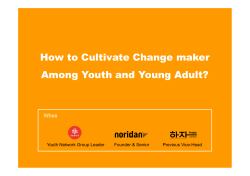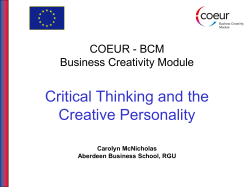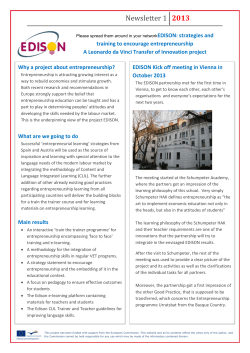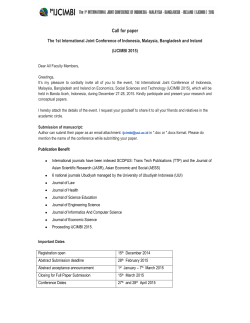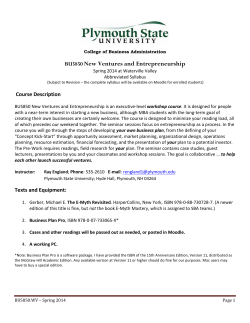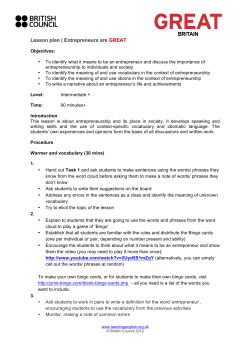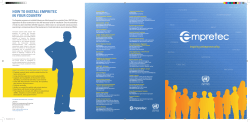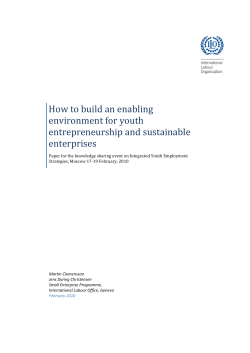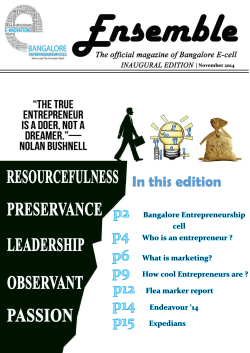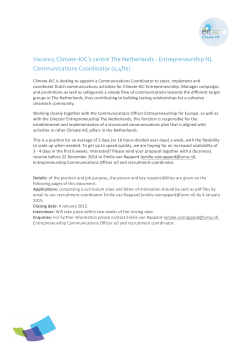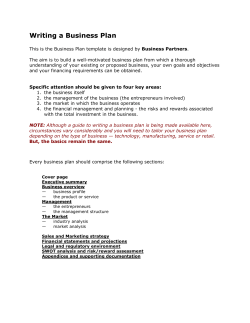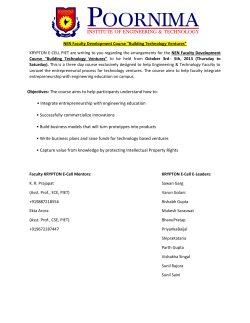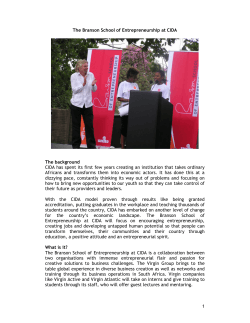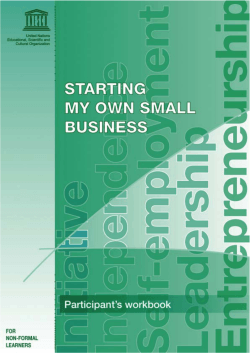
Change Making Patterns A Pattern Language for Fostering Social Entrepreneurship Eri Shimomukai
Change Making Patterns A Pattern Language for Fostering Social Entrepreneurship Eri Shimomukai Sumire Nakamura Takashi Iba Faculty of Policy Management, Keio University Abstract By conducting interviews with social entrepreneurs, we created a pattern language, which we named “Change Making Patterns.” The objective of these patterns is to encourage more individuals to take own actions in making a better world with less social problems. In this paper, we provide the background of the patterns and how they can be applied for social entrepreneurial education. We also include results and the observations from the workshop trials and suggestions on an educational program for future social entrepreneurs. Furthermore, this paper presents five essential patterns for the educational programs. 1. Introduction The field of social entrepreneurship is growing rapidly and attracting attention from many different sectors. People are attracted to social entrepreneurs - extraordinary people that come up with great ideas and create new products and services that dramatically improve people lives. In the meantime, not only certain talented people such as “social entrepreneurs” need to tackle a variety of problems in society, but also each individual should be have a social entrepreneurial mindset to acquire “social entrepreneurship” in order to make a better world [1]. The demand of this field has increased since the Japanese government has called for a need to create a “New Public Commons” [2], which is a society where various individual stakeholders including individuals voluntarily work together. If everyone has a place to go and role to play, people will value the pleasure of helping others, and this results in generating required markets and services. Nevertheless, it is still difficult to share guidelines applicable to a variety of people in different situations. People who defined the word “social entrepreneurship,” such as David Bornstein [3], discovered common characteristics through careful observation and analysis. Clearly, there are a number of common solutions and rules that have appeared in similar contexts. We believe that there is a need for a pattern language that describes the problems that social entrepreneurs typically face and the methods 1 their problems are typically solved [4]. Therefore, our goal is simply to identify and describe the patterns for social change, and provide them as “tips” written in the understandable language in order to educate more people who have the knowledge of social entrepreneurship. If we could achieve this goal, the number of social issues would decrease in the future [1]. Nevertheless, pedagogical development and research for social entrepreneurship education have received relatively little attention [5]. There are few media that teach social entrepreneurship to people and encourage them to take actions. To address this, we expect that Social Entrepreneurship Patterns function as educational material to support people to understand methods for making changes on social issues [6]. To encourage engagement on social issues, Paul Tracey suggests a number of pedagogical approaches ranging from in-class curriculum to co-curricular creation of social ventures [7]. While these educational approaches offer value to students, one significant omission is the use of simulation. From a pedagogical perspective, a simulation offers an innovative approach for experiencing the complex nature of social entrepreneurship [8]. Therefore, we are willing to provide the educational programs that the readers simulate the social entrepreneurship patterns in experiential learning. In addition, simulative programs encourage potential social entrepreneurs in generating empathy with social issues that motivates social entrepreneurs to take actions [8]. 2. Structure of Change Making Patterns Change Making Patterns consists of 31 patterns. Those 31 patterns are categorized into two main levels and six phases. Each level and each phase have its own objective. Figure 1 shows the two main levels and six phases of the pattern language and the corresponding patterns in each phase. This paper present 5 essential patterns for social entrepreneurial education. The first level is Self-Empowerment Level, and the second level is Change Making Level. Throughout the process of making the patterns, we discovered that social entrepreneurs not only share tips for making changes or taking actions on social issues, but also commonly have self-empowerment patterns. In short, they reflect on and empower themselves before they take action toward social problems. Often, social entrepreneurs start with self-empowerment, yet they come move back and forth between two levels. In Self-Empowerment Level, there are two phases: Mindset and Mission- defining. Patterns in Mindset phase create powerful incentives within the readers to make critical changes on social issues. The Mindset phase contains a pattern: Know Yourself. A pattern in Mission-defining phase clarifies what and why the readers need to do. Mission-defining phase contains a pattern: 3W1H. 2 In Change Making Level, there are four phases: Preparation, Change Construction, Implementation, and Scale-out. Patterns in Preparation promote the reader to step forward into the field of their own issues. Preparation phase consists of a pattern: Field Diving. Patterns in Change Construction show how to think up the theory of change based on social mission and vision. The phase consists of a pattern: Sustainable System. Patterns in Implementation teach some specific strategy for shaping ideas into form. This phase consists of a pattern: Success Prototyping. Finally, patterns in Scale-out phase provide tips for expanding projects. Patterns in this phase consist of a pattern: Evangelists. Figure 1. The Structure of the Change Making Patterns 3. Application to the Educational Programs In order to promote readers to implement the patterns and create more social impacts, we propose an educational program that applies the social entrepreneurship patterns. The programs consist of four contents; dialogue workshops with the patterns, project design with the patterns, pattern implementations, and pattern writings. The ultimate objective of the program is to encourage the readers or potential social entrepreneurs to understand the patterns and utilize them for making changes on specific social issues. Figure 2 shows how the three contents are connected. 3 Figure 2. The contents on the educational program with the Change Making Patterns 3.1 Workshop and Project Design The workshop consists of three different activities: improvisation activity, dialogue, action planning. Games based on improvisation encourage the participants to understand the meanings of the patterns with physical movements. In dialogues, participants talk about their experiences on every action or activity with the patterns, and exchange them with other participants. The objective of the workshop is to stimulate readers to acquire a new vocabularies for communicating on the social entrepreneurial topic, insightful ideas, and deeper understanding on the patterns [9]. After mastering the patterns with improvisational games and dialogues, the readers plan how they implement the patterns that they have gained throughout the game on their own projects, including short term goals and consequences. Then, they move on constructing a project plan based on their awareness of social issues using the gaining patterns. 3.2 Pattern Implementation For a certain period, we encourage the readers to proceed with their own projects and implement 4 the social entrepreneurship patterns. The readers have an opportunity to share how they have experienced the patterns and how they have been approaching to the issue. According to the experiential learning theory, knowledge is created through the transformation of experience, which means that knowledge results from the combination of grasping and transforming experience [10]. Thus, readers are required to have opportunity to implement the pattern on concrete projects or field to embody patterns and transform the patterns into the social impacts. 3.3 Pattern Writing Finally, we are planning to have pattern writing workshops where the reader writes patterns using their experiences in the field. Writing patterns encourage them to reflect on their learning, and some patterns would be useful on their learning for potential social entrepreneurs. This process is essential for constructing social capitals that is defined as the existence of a certain set of informal values and norms shared among members of a group that permit cooperation among them [11]. 4. Patterns In this paper, we present five patterns from Change Making Patterns: Know Yourself, 3W1H, Field Diving, Success Prototyping, and Evangelists. These patterns are written for anyone who desire and strive to change the world regardless of age or nationalities. Every pattern is written in the same format: pattern name, introductory sentence, quote, illustration, context, problem, forces, solution, action, consequence, and example. 5 No.1 Know Yourself Social entrepreneurship starts with “myself”. Quote: “Follow effective action with quiet reflection. From the quiet reflection will come even more effective action.” By Peter Drucker Context: You are interested in starting a project related to social issues. ▼ Problem: Since you have no idea what you wish to do or how you can approach to the issue, you cannot move on to start a new project. People are motivated when they work on things related to their interests and their strengths. People act based on their backgrounds and characteristics. It is difficult to come up with an original plan in the beginnings. ▼ Solution: Know who you are and your capabilities before you take a step forward. Spare your time to contemplate on your desires, and seek your true feelings. Then, identify your strengths and weaknesses by reviewing the turning points in your personal experiences or talking about yourselves with people who know you well. After Filed Diving (No.3) and interacting with the people concerned, ask yourself what you can do with them. ▼ Consequence: You are capable of having authentic approaches toward the social issue that you wish to solve. As a result, you can differentiate your approaches from others. 6 Example: During her school years at Keio University, Ms. Takako Yamada encountered the reality of the street children in the Philippines and believed that she can use sports as a solution. After realizing that making children play sports wouldn’t solve issues, Ms. Yamada kept asking herself what she could to help the children and concluded that creating their independency through business was the answer to her question rather than being in a helped-or-help relationship. Even after starting a business, which offers online English classes for Japanese customers, recruiting English-speaking youth in the Philippines as instructors, she continues to question “what do I want to accomplish?” 7 No.2 3W1H Start with asking yourself, “Why, What, Who and How do you want to provide?” Quote: “As with every phenomenon of the objective universe, the first step toward understanding work is to analyze it.” By Peter Drucker Context: You have found the social issue, which you are passionately willing to tackle, and you are now thinking about how to approach it. ▼ Problem: You may come up with a method of creating an immediate impact, but you are not clear about your sustainable implementation plan. • People tend to think liner when they are facing problems. • People easily forget their objectives when they need to create new concepts or ideas. ▼ Solution: Think about Why, What, Who and How do you wish to solve the problem you are facing. First of all, ask yourself why you are willing to or have to tackle the issue. Then, simply think about what and to whom you wish to provide. Field Diving (No.3) helps you to obtain the clear answers to those four questions. Finally, you need to work on creating the path to accomplish your mission. ▼ Consequence: Those four simple questions lead you to define your mission. As a result, this process encourages you to uncover your creative insights and approaches to the solution and leads to stronger impacts on solutions. 8 Example: Even before and after starting business, Ms. Takako Yamada pondered the what, why, who, and how questions. In order to resolve (what) poverty in the Philippines, (who) the youth aided by the local NGO needs to (why) enjoy working and self-realize their worthiness, cultivating their own future with their own hands. (How) Then she realized that she needs to create a system in which the youth can be responsible and earn by their own effort. 9 No.3 Field Diving Immerse yourself in the field on the issue. Quote: "Whatever you can do, or dream you can, begin it. Boldness has genius, power, and magic in it." By Goethe “The way to get started is to quit talking and begin doing.” By Walt Disney Context: You have found the social issue which you want to solve, and are on the way of thinking about effective solutions. ▼ Problem: Even though you have a vague image and a hypothesis on people’s concerns, you are still not clear about the actual needs. The problems you are trying to solve are rarely your own. You have a few chances to interact with the people concerned. ▼ Solution: Dive into the field of the people concerned. Go to the place where you can find the people who you want to help, or where the problem actually occurs. Observe them and their behaviors in the context of their lives. Interact with them through interviewing and experiencing what they have gone through in their lives and spend as much time as you can to empathies with the people concerned. ▼ Consequence: You can build empathy for the people concerned, which encourages you to uncover your insights. As a result, you come aware of more fundamental issues behind the surface. 10 Example: Establishing a company, ShuR, which aims to improve the lifestyles of hearing-impaired people by using technology, Mr. Junto Ohki firstly noticed that the people having difficulties need more leisure, so he decided to create the travel TV program. While he was spending a lot of time with the people concerned, Mr. Ohki confronted a bigger issue. For instance, he noticed the problem that hearing-impaired people have difficulties to be seen by doctors in emergencies because they need help from sign language interpreters. 11 No.4 Success Prototyping Keep moving your hand to create success for convincing supporters. Quote: “The world is a dangerous place, not because of those who do evil, but because of those who look on and do nothing.” By Albert Einstein Context: You have already initiated your own project and want to gather more supporters and customers to expand your project. ▼ Problem: Since you have not tested your ideas, there is no reliable outcomes so you can get powerful supporters. • You can hardly obtain trust from people until you have reliable outcome and results. • It is hard to create great success at the beginning. ▼ Solution: Prototype your plan in your project and attempt making the some successful cases. Find a specific field, and implement even a small program or a rough plan. For instance, you can try a pilot program, or provide a prototype service for free. Ask the initial users to evaluate your prototype and give some good points and rooms to improve. Improve those prototypes and gain credibility by reflecting on feedbacks from the initial users. ▼ Consequence: The more you have credibility, the better you have a chance in obtaining support, collaborating with investors, and expanding your project. 12 Example: Mr. Ryo Imamura, a senior executive manager at a NPO, Katariba is playing a vital role in helping to build career awareness of students by providing a place to interact. However, he was stuck in a situation where he had little opportunities to interact with high school students thus having trouble testing his ideas in the market. As an exit strategy, he targeted one school and called for undergrad volunteers to share their stories with high school students, which became a successful prototype that became the base of his business model. Soon after, such business spread due to its accomplishments and results by word of mouth. 13 No.5 Evangelists Involve the key person who brings great influence on your project. Quote: For social entrepreneurs working with private companies, "building of mutual trust is crucial, otherwise the dialogue remains superficial" By David Carrington Context: You have started implementing your project, and it is on the right track. ▼ Problem: You are struggling to find new markets and customers to expand your project. • Projects tend to succeed in one particular community at the early stages. • Unless people actively seek chances, it is difficult to acquire new opportunities. ▼ Solution: Meet with Evangelists, people who have authority in any field. Take advantage of the connection you have with them. Show your strengths and concerns of your business model and leverage the relationship with Evangelists, such as politicians and celebrities. For instance, you can invite them to your fundraising events or ask them to try your service. You can co-create to come up with and implement new ideas or plans with your Evangelist. ▼ Consequence: Due to networking with influential people, you have a better chance of expanding your advertisement channels. Consequently, you will gain more recognition among potential customers. 14 Example: Looking for evangelists and seeking advice on his concerns about business expansions with only one business model, Mr. Ryo Imamura of Katariba met an evangelist who devoted himself in policy management of pressure-free education at Ministry of Education, Culture, Sports, Science, and Technology. After talking about new strategies and opportunities, Mr. Imamura came up with an effective breakthrough, which offers a platform for adults and students to interact with perspectives of the field of education and policy on how to enhance education. 15 5. Conclusion Through conducting workshops with the patterns, we found out that it is necessary to convey the meaning of the patterns to readers transparently. Thus, interactive activities such as improvisation and dialogue are significant in terms of deepening the readers’ understanding. However, it is going to be crucial to devise plans for encouraging readers to take action with the patterns. Therefore, we suggest that patterns should be used in projects or some sort of action while it is essential to improve comprehensibility of the patterns. Action planning with patterns leads the reader to go beyond the level of current significance; the reader will be able to plan their future actions with the patterns. Acknowledgment I am deeply grateful to Yumeno Nito, Hiroshi Ogawa, Rikako Sano, Takako Yamada, Takamasa Matsuura, Ryo Imamura, and Junto Oki who were generous enough to volunteer as interviewees and revised the patterns. Also, my heartfelt appreciation goes to Prof. Yuichiro Shimizu whose comments and suggestions were on inestimable value for my studies. References [1] David, B. & Susan, D. (2010) Social Entrepreneurship: What Everyone Needs to Know. Oxford University Press. [2] Ikuyo K. (2010) “Declaration of “New Public Commons””. Cabinet Office, Government of Japan. [2] David, B. (2004) How to Change the World: Social Entrepreneurs and the Power of New Ideas. Oxford University Press. [3] Alexander, C., Ishikawa, S., & Silverstein, M. (1977) A Pattern Language: Towns, Buildings, Construction: Oxford Press. [4] Brock, D., S. Steiner & M. Kim. (2008) “Social entrepreneurship education: is it achieving the desired aims?”, United States Association for Small Business and Entrepreneurship (USASBE) Conference Proceedings. [5] Shimomukai, E. & Iba, T. (2012) “Social Entrepreneurship Patterns: A pattern Language for Change-Making on Social Issues,” in 17th European Conference on Pattern Languages of Programs (EuroPLoP 2012). [6] Tracey, P. & N. Phillips. (2007) “The distinctive challenge of education social entrepreneurs: a postscript and rejoinder to the special issue on entrepreneurship education”, Academy of Management 16 Learning & Education. [7] Smith, B. & Jill, K. & Linda, C. (2010) “Using simulation to develop empathy and motivate agency: an innovative pedagogical approach for social entrepreneurship education”, Handbook of Research in Entrepreneurship Education: International Perspectives. [8] Iba, T. & Sakamoto, M., (2011) “Learning Patterns III: A Pattern Language for Creative Learning,” in 18th International Conference on Pattern Languages of Programs (PLoP2011). [9] Hmieleski, K. & Corbett, A, (2006) "Proclivity for Improvisation as a Predictor of Entrepreneurial Intentions,” Journal of Small Business Management. [10] Kolb, D. (1999) “Experiencial Learning Theory: Previous Research and New Directions,” NJ: Lawrence Erlbaum. [11] Fukuyama, F. (1997) “Social Capital and Development,” The SAIS Review. 17 Appendix: Implementation of the Workshop We implemented a trial workshop with the change making patterns on August 24th, 2012. Each having diverse backgrounds from Asia and America, the participants were 36 students who are interested in taking action in the social sectors or have already have been engaging in some social entrepreneurial activities. The workshop was held as one of the workshops in the study program on social innovation at Silicon Valley. The objectives of the workshop is to deepen the participants’ understanding on social entrepreneurship, to enhance their skills of problem solving on social issues, and to design their action plans on their projects in their own country with the patterns. Each of the participants get involved in the projects related to social problems such as poverty, natural destruction, and equality in education, thus we encourage them to apply those patterns to their projects in order to multiply the impact. Format of the workshop The workshop consists of three different activities: improvisation activity, dialogue, and action planning. Games based on improvisation encourage the participants to understand meanings of the patterns with physical movements. During dialogues, the participants explain their experiences and specific episodes, which are related to the patterns they have experienced, to other participants who are eager to gain the pattern. At the end of the workshop, the participants reflect on what they learn from other participants’ episodes and how they can embody the pattern on their projects with a worksheet. All the improvisational games are correlated with the solution of each pattern. Goals of improvisational games are to learn the pattern not only from written languages but also physical activities, and master creativity and risk-taking skills, which are the aspects of social entrepreneurial mindset. In fact, when recourse constrains are prohibitive, the social entrepreneur finds himself/herself face with a significant problem or opportunity, then improvisation appears to be the most reasonable course of action. The dialogue workshop is designed for all participants to reflect on their experiences by talking about specific episodes corresponding to the patterns, and acquire clearer images on the patterns which they are eager to gain by listening to other participants’ personal stories with the vocabularies in the patterns. After the dialogue, we provided the time for reflection with the pattern that they selected on the worksheet. In addition to summarizing the episodes that they listen from other participants, they plan their actions on their own project or their daily life. Figure 3 shows the format of the worksheet. Participants are required to write down plans on how they implement the pattern and initial actions based on what they learn from the 18 dialogue and languages on the patterns themselves. This process highly encourages the participants to embody the patterns in order to create even small changes on social issues. Figure 3. Action planning worksheet that we use during the reflection Results During the improvisational activities, we provided two different activities related to two of the root patterns: Know Yourself and Energy Boost. For teaching Know Yourself, we conducted the interview games that we divided into groups of two, and interviewers can ask only one question, which is “Who are you?” Interviewees have to come up with a word or short phrase that represent their own personalities, temper based on their past experiences. The participants were required to present as many answers as possible in four minutes. As time went by, participants were struggling with coming up with answers. On the other hand, according to the survey to the participants, words or phrases that they said in the end of the game described more hidden or unrecognized personalities. 73% of the participants answered that inquiry activity helped them to know more about their personal capabilities. The second improv activity is corresponding to the other root pattern, Energy Boost. First, each participant wrote down their “energy boost,” things that energize them to take actions or keep active. Then, they post them on the wall, and other participants looked around all others’ “energy boosts” and selected five of them that they wish to gain. Several participants indicated that this activity was a great opportunity to be exposed to a variety of new concrete ideas, which they have never thought of. In addition, one of the participants pointed out that it would be very challenging to acquire the concrete solution if they read only the pattern. Among 36 participants, 75% of them, 27 participants, could listen to the episodes on all of five patterns that they selected as the patterns which they are eager to gain during 45 minutes. However, 19 according to the survey, 36% of the participants found that some of the participants misunderstood the meaning of the pattern, so the episodes did not help them to draw clear images on the patterns. Observations Through having two different types of the activities whose objective was to encourage participants to deepen understandings on the patterns, we could compare them and find strengths and weaknesses. Since improvisations require physical movements and interactions, participants are able to acquire the patterns with joy and excitement. Also, the level of understanding about each pattern was quite high when we had improvisational activities. However, it took time to teach each pattern. On the other hand, the dialogue inclusively covered all the patterns within 45 minutes, so the participants equally had chances to talk about the patterns according to their experiences. Moreover, they could acknowledge that their experiences are essential for themselves, which leads to build their confidence. Due to misunderstandings over the patterns, the level of understanding was uneven. As a result, the type of workshop can be adapted according to the purpose. If the purpose arranged is making participants understand the patterns precisely and memorize them, improvisational activities would work better than dialogue, yet dialogue is effective in terms of completeness of the patterns. 20
© Copyright 2025
